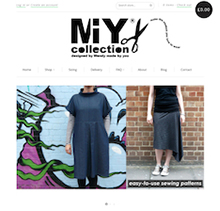

This month in Love Sewing magazine I’m writing all about pressing. It’s issue 22 and is available now for just £6.99. One of the questions I answer is about pressing cloths and as it’s a much under-rated bit of pressing kit I’m including it here too!
A pressing cloth will be one of the cheapest and most used items in your pressing tool kit. It protects your fabric by preventing sheen, protecting against scorching and melting and protects your iron against fabric melting and sticking to the sole plate or poor quality printing transferring to your iron.

Place the pressing cloth between your fabric and the iron, then press as normal.
When to use a pressing cloth?
Always use a pressing cloth on:
- coating weight wools – so you can use a really high heat
- silks and delicate, fine fabrics to prevent marking
- synthetic fabrics – if you’re unsure about how they’ll press
- scuba – it’s a synthetic fabric, prone to melting at high temperatures, but thick and seams need to be pressed
- PVC, pleather, oilcloth – these fabrics are all difficult to press, but you need to be able to flatten seams to get a nice finish.
Always use a pressing cloth when ironing on fusible interfacing; your interfacing will stick much faster, more evenly, is less likely to start coming off during sewing and most importantly, you won’t ever have a molten mess of interfacing stuck to the sole place of your iron!
Using a pressing cloth is pretty old technology.
A damp pressing cloth used with a dry iron was the only way to generate steam before steam irons were available. In fact many tailors still choose a damp pressing cloth and dry iron over a steam iron to minimise any marking of the cloth.
You can buy pressing cloths, but why would you?!
A simple piece of unbleached or white cotton muslin is the most basic and most used pressing cloth, but you can go to town and have a whole pressing cloth collection:
- Cotton (NOT poly/cotton – the polyester content will melt) muslin makes a good general use pressing cloth.
- Plain woven cotton canvas is good for very delicate fabrics that can’t withstand much heat but need a lot of pressing, using these damp can also help with pressing delicate fabrics.
- Silk organza sounds like a rather extravagant pressing cloth but will be really useful and you don’t need masses; its transparency is the main advantage – you can get a much clearer view of what’s happening underneath a silk organza pressing cloth! It can also withstand a high heat and has a nice smooth surface meaning no textured imprint will be transferred to your fabric.
Finally, don’t get lazy and use the pressing cloth to avoid changing the settings on your iron! They’re best used in conjunction with the correct settings on your iron for the fabric you’re pressing.
Read my recommendations for what other accessories will improve your pressing here.



















Pingback: Silk Dress: Tips for Flawless Look - Alesayi Fashion
Pingback: DIY Table Runners: No Sewing Necessary! – Nordic Fiber Arts
Pingback: How To Iron A Satin Wedding Gown – RobertGeller-ny
Pingback: Sustainable Laundry Tips | Wendy Ward
Pingback: What Is The Difference Between Pressing and Ironing?
I have a discoloured Rajan pressing cloth. Can I wash it in the machine or does this affect the chemicals it has been treated with?
LikeLike
I don’t know what a “rajan pressing cloth” is??
LikeLike
Pingback: Sewing Tools And Equipment | The Creative Curator
Pingback: Top Ironing Accessories Every Laundry Room Should Have | SmoothWares.com
Is a pressing cloth washable?
LikeLike
Absolutely! !
LikeLike
These are great tips!
I finally know what a pressing cloth is best used for, I was rather hazy on that point. Thank you so much Wendy! Extremely good information as always.
LikeLike
Thanks Giselle, so glad it’s a helpful post for you!
LikeLike